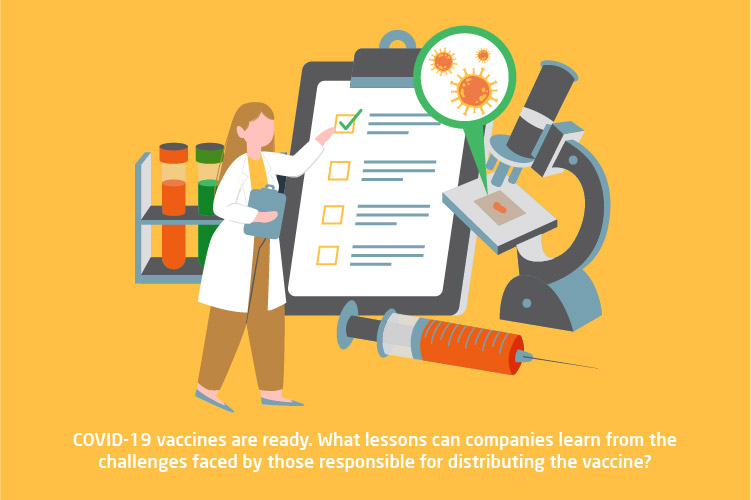In record-setting time, medical researchers and pharmaceutical manufacturers were able to create a highly effective vaccine for SARS-CoV-2, the virus that causes COVID-19 disease.
The first documented cases of COVID-19 were in December 2019. Only a year later, a vaccine from Pfizer and BioNTech was granted an emergency use authorization by the U.S. Food and Drug Administration. Moderna’s alternative received the same regulatory approval shortly thereafter.
This timeline shattered the previous record of four years, for the mumps vaccine in the 1960s. Moreover, the SARS-CoV-2 vaccine itself represented a major leap forward in vaccine technology, being the first vaccine to use synthetic messenger RNA (mRNA) to direct the creation of specific proteins within cells.
However there is still a long way to go in actually distributing the Pfizer and Moderna vaccines, plus others that are entering the market, to people. The complex logistics of managing the vaccine cold chain, combined with the limited government funding to support distribution, will make widespread vaccination a challenge in 2021 and beyond.
What are the major roadblocks to COVID-19 vaccine distribution?
Logistics firm Boyle Transportation estimates that over 14 billion doses of COVID-19 will need to be delivered worldwide by 2023, or approximately two doses per person on earth (most COVID-19 vaccines require multiple injections). That volume would be challenging on its own.
Per Bloomberg’s tracker of vaccinations in the U.S., as of Dec. 28, 2020, only 2.1 million doses of 15.7 million allotted first doses had been officially administered, underscoring the difficulty in optimizing supply chains to meet immense demand. Moreover, scale isn’t the only problem – there’s also the high temperature sensitivity of COVID-19 vaccines.
Supply chains for COVID-19 vaccines are cold chains. Pfizer has noted that its vaccine must be kept at -70 degrees Celsius, plus or minus 10 degrees. Keeping every dose at that temperature will put lots of pressure on existing cold chain infrastructure:
- Dry ice is essential to keeping these vaccines cool. Members of the compressed gas industry, which mass-produces the carbon dioxide in dry ice, have differing views on whether production will be adequate for scalable vaccine distribution.
- The drop in driving in the wake of the COVID-19 pandemic also spurred a reduction in the production of ethanol, which yields CO2 as a byproduct for dry ice production. Ethanol bottlenecks have already led to some regional dry ice shortages, especially in rural areas.
- Dry ice is classified as hazardous cargo by the Federal Aviation Administration, limiting how much of it can be moved via air. Extreme care is needed to ensure safe transport, plus the room it requires on its own can reduce how much vaccine can be shipped.
- Cold chain capacity that is normally used for items like fruits and vegetables may be needed to move vaccines instead. This could have negative economic impacts in regions that rely on exports of produce like avocados or bananas, for instance.
What happens if the cold chain breaks down? The World Health Organization estimated that 2.8 million doses of vaccines were lost in 2011 across five countries due to cold chain failures. It also documented how nations like Turkey had needed to increase their storage capacity by 20% in response to new vaccine introductions. The sheer scale of the COVID-19 vaccination campaign will lead to worse outcomes if supply chains can’t deliver consistent temperature control.

Limited funding further complicates distribution
Per The American Prospect, only $200 million in federal funding had been allocated to COVID-19 vaccine distribution as of December 2020. That’s not much considering the scope of the project and the widespread need for freezers capable of reliably storing doses.
With money in short supply, vaccine distribution will be challenging. Even highly successful vaccination initiatives like the Vaccines for Children program top out at 3 million doses per year, far short of the hundreds of millions of doses that will be needed to quickly contain the COVID-19 pandemic.
Many Consumer Goods and Retail companies face similar logistics and supply chain challenges to those faced by the people in charge of distributing the COVID-19 vaccine. Our customers, including Boar’s Head and Land O’Lakes, must both take into account the complexities of keeping their products cold while distributing them across the country. For these companies and all companies with complex logistics operations, improving the supply chain in any way possible and streamlining the logistics process will be important in 2021 and beyond. Inspirage, an experienced and recognized Oracle partner, can help your organization implement economical and reliable logistics processes. Contact our team to learn more.